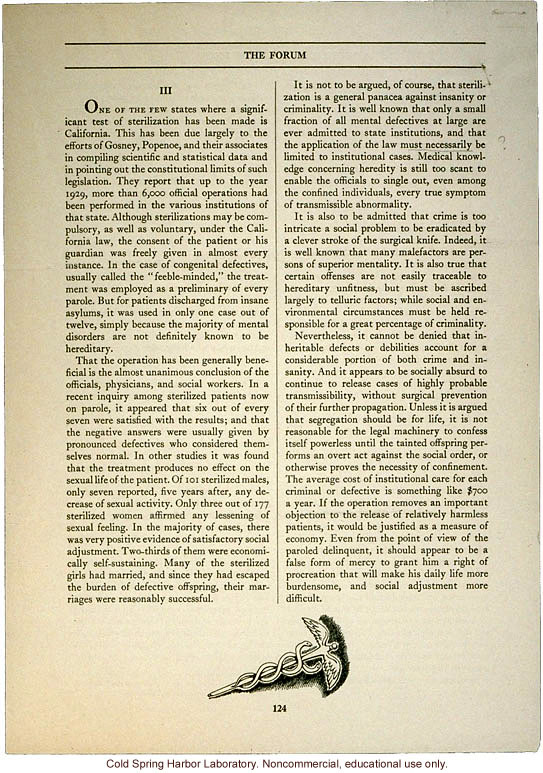[hairline rule]
The Forum
[hairline rule]
III
One of the few states where a significant test of sterilization has been made is California. This has been due largely to the efforts of Gosney, Popenoe, and their associates in compiling scientific and statistical data and in pointing out the constitutional limits of such legislation. They report that up to the year 1929, more than 6,000 official operations had been performed in the various institutions of that state. Although sterilizations may be compulsory, as well as voluntary, under the California law, the consent of the patient or his guardian was freely given in almost every instance. In the case of congenital defectives, usually called the "feeble-minded," the treatment was employed as a preliminary of every parole. But for patients discharged from insane asylums, it was used in only one case out of twelve, simply because the majority of mental disorders are not definitely known to be hereditary.
That the operation has been generally beneficial is the almost unanimous conclusion of the officials, physicians, and social workers. In a recent inquiry among sterilized patients now on parole, it appeared that six out of every seven were satisfied with the results; and that the negative answers were usually given by pronounced defectives who considered themselves normal. In other studies it was found that the treatment produces no effect on the sexual life of the patient. Of 101 sterilized males, only seven reported, five years after, any decrease of sexual activity. Only three out of 177 sterilized women affirmed any lessening of sexual feeling. In the majority of cases, there was very positive evidence of satisfactory social adjustment. Two-thirds of them were economically self-sustaining. Many of the sterilized girls had married, and since they had escaped the burden of defective offspring, their marriages were reasonably successful.
It is not to be argued, of course, that sterilization is a general panacea against insanity or criminality. It is well known that only a small fraction of all mental defectives at large are ever admitted to state institutions, and that the application of the law must necessarily be limited to institutional cases. Medical knowledge concerning heredity is still too scant to enable officials to single out, even among the confined individuals, every true symptom of transmissible abnormality.
It is also to be admitted that crime is too intricate a social problem to be eradicated by a clever stroke of the surgical knife. Indeed, it is well known that many malefactors are persons of superior mentality. It is also true that certain offenses are not easily traceable to hereditary unfitness, but must be ascribed largely to telluric factors; while social and environmental circumstances must be held responsible for a great percentage of criminality.
Nevertheless, it cannot be denied that inheritable defects or debilities account for a considerable portion of both crime and insanity. And it appears to be socially absurd to continue to release cases of highly probable transmissibility, without surgical prevention of their further propagation. Unless it is argued that segregation should be for life, it is not reasonable for the legal machinery to confess itself powerless until the tainted offspring performs an overt act against the social order, or otherwise proves the necessity of confinement. The average cost of institutional care for each criminal or defective is something like $700 a year. If the operation removes an important objection to the release of relatively harmless patients, it would be justified as a measure of economy. Even from the point of view of the paroled delinquent, it should appear to be a false form of mercy to grant him a right of procreation that will make his daily life more burdensome, and social adjustment more difficult.
[graphic]
124
[end]


